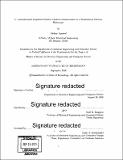| dc.contributor.advisor | Karl K. Berggren. | en_US |
| dc.contributor.author | Agarwal, Akshay | en_US |
| dc.contributor.other | Massachusetts Institute of Technology. Department of Electrical Engineering and Computer Science. | en_US |
| dc.date.accessioned | 2017-02-22T19:03:35Z | |
| dc.date.available | 2017-02-22T19:03:35Z | |
| dc.date.issued | 2016 | en_US |
| dc.identifier.uri | http://hdl.handle.net/1721.1/107101 | |
| dc.description | Thesis: S.M., Massachusetts Institute of Technology, Department of Electrical Engineering and Computer Science, 2016. | en_US |
| dc.description | "September 2016." Cataloged from PDF version of thesis. | en_US |
| dc.description | Includes bibliographical references (pages 56-62). | en_US |
| dc.description.abstract | Wavefront-division electron interferometry with the electron biprism has enabled many applications such as electron holography, exit-wave reconstruction, and demonstration of the Aharonov-Bohm effect. However, wavefront-division interferometry is limited by the requirement of high source coherence. Amplitude-division electron interferometers, first demonstrated by Marton and co-workers in 1954, can overcome this limitation. The implementation of these interferometers is hindered by the precise rotational and translational alignment required. This thesis develops a self-aligned, monolithic electron interferometer consisting of two 45 nm thick silicon layers separated by 20 gm and fabricated from a single crystal silicon cantilever on a transmission electron microscope grid by gallium focused ion-beam milling. Using this interferometer, beam path-separation and interference fringes of lattice periodicity and a maximum contrast of 15% in an unmodified 200 kV transmission electron microscope was demonstrated. This interferometer design can potentially be scaled to millimeter-scale and used in electron holography. It can also be applied to perform fundamental physics experiments such as interaction-free measurement with electrons, with the aim of significantly reducing the damage suffered by biological samples during high-resolution microscopy. Thus, the interferometer can serve as a proof-of-concept of the recently proposed 'Quantum Electron Microscope'. | en_US |
| dc.description.statementofresponsibility | by Akshay Agarwal. | en_US |
| dc.format.extent | 62 pages | en_US |
| dc.language.iso | eng | en_US |
| dc.publisher | Massachusetts Institute of Technology | en_US |
| dc.rights | MIT theses are protected by copyright. They may be viewed, downloaded, or printed from this source but further reproduction or distribution in any format is prohibited without written permission. | en_US |
| dc.rights.uri | http://dspace.mit.edu/handle/1721.1/7582 | en_US |
| dc.subject | Electrical Engineering and Computer Science. | en_US |
| dc.title | A nanofabricated amplitude-division electron interferometer in a transmission electron microscope | en_US |
| dc.type | Thesis | en_US |
| dc.description.degree | S.M. | en_US |
| dc.contributor.department | Massachusetts Institute of Technology. Department of Electrical Engineering and Computer Science | |
| dc.identifier.oclc | 971483031 | en_US |
